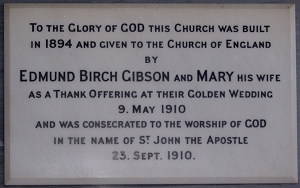History of St John's
 St John’s Church, Little Walden celebrated its one hundredth birthday in 2010.
St John’s Church, Little Walden celebrated its one hundredth birthday in 2010.
In the early days Little Walden’s ‘Mission Chapel’ (now St. John’s Church) was built in 1893-4 by the Quaker landowner and banker Edmund Birch Gibson, on his own land and with the work being carried out by his estate workers. He built it after a request for help from the Vicar of Walden, the Reverend Pelly, but, nervous of the ‘Romanising’ tendencies of a previous vicar he at first only loaned the chapel to the Church of England.
The architect, Edward Burgess was a family friend of the Gibsons and also a member of the Society of Friends. He had previously designed other buildings in Saffron Walden: the Friends’ School (1879), the new Town Hall (1880), the Grammar School (1881, now the Dame J. Bradbury School) and the Training College for Mistresses (1884, which later became the Bell College). Born in Leicester, to an old Quaker family in 1847, he practiced in Leicester and London, specialising in schools. He also worked on a number of civic and commercial buildings, and some large country houses. He died in London in 1929.
On 9th May 1910 Edmund and his wife Mary made an outright gift of the land and building to the Ecclesiastical Commissioners, on the occasion of their Golden Wedding Anniversary. At the Service of Thanksgiving the deed of conveyance was presented to the Churchwarden William Favill Tuke: “We present this Church to the Ecclesiastical Commissioners of England as a thank offering to Almighty God for fifty years of happy married life. May the blessing of God rest upon the Services that are held in this building”.
As an outright gift, and with an endowment, the Church could then be consecrated, and this took place on 23rd September in the same year. It was dedicated to God in honour of St. John the Apostle.
St John’s Church is one of only two Churches in the country that have been passed over to the Church of England from the Quakers.